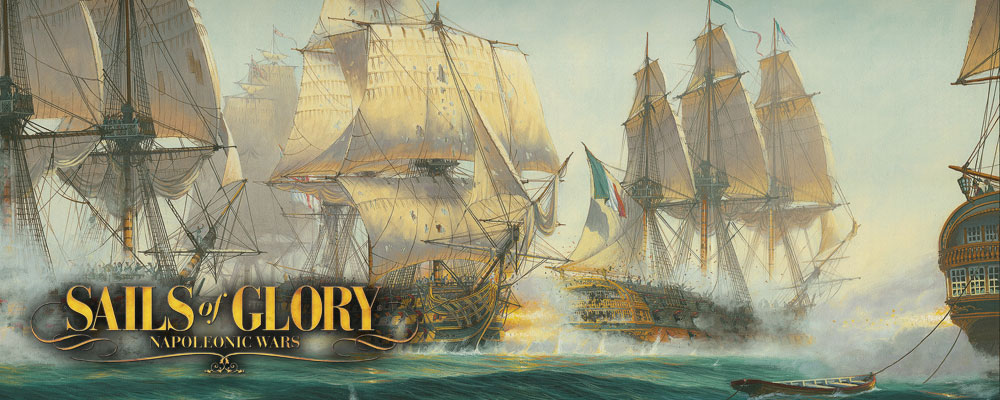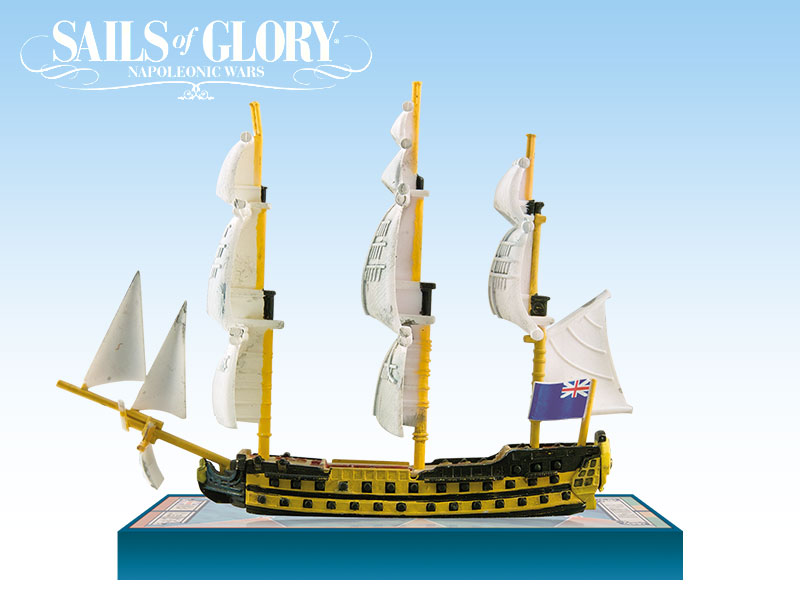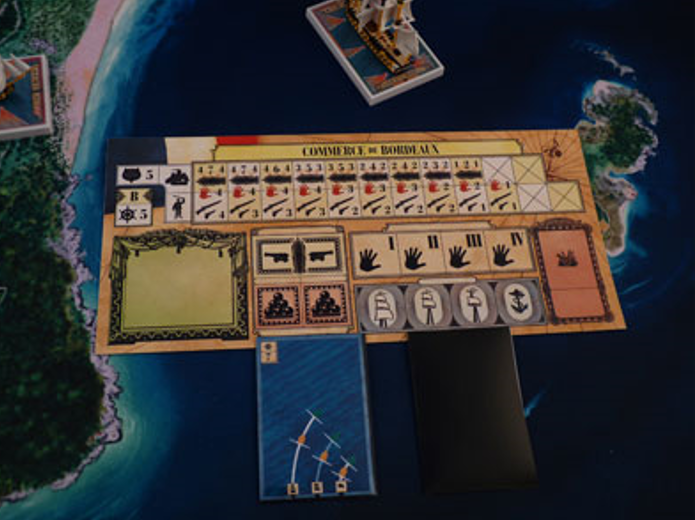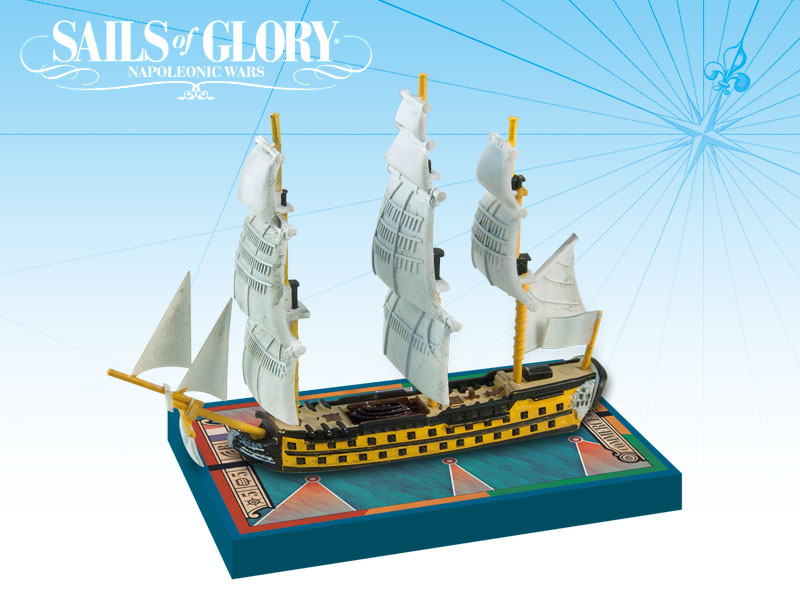April – 1805
Napoleon Is Master Of Europe
Only The British Fleet Stands Before Him
Oceans Are Now Battlefields

If miniature wargaming is a niche, naval wargaming is a niche within a niche. This is actually a bit surprising, considering you only need a handful of ships and something large and blue to play on. It could be said that naval games look a bit less spectacular than a 6×4 crammed with pikemen, or other, lesser types of troops, but it is actually the easiest way to get into historicals provided you have some pre-painted models and a ruleset that doesn’t cause you to retire to the fainting couch with a splitting headache after a few turns, probably with an intense dislike for artillery tables.

As luck would have it, Ares Games did think of this a couple of years ago, and since we’re focusing on Napoleonics this month, it’s as good a time as any to unfurl our sails and lift anchors. We’ll be looking at the starter and some expansion packs, and the mechanics that drive the system. While the game doesn’t give any historical background other than “Age of Sail”, the ships in the starter and expansion packs are named ships from the Napoleonic conflicts, and you can actually look most of them up, as most do have a bit of background history. The Généreux (1785) from the starter for example, also saw use in the British Navy after being captured in 1800. You’ll have to do your own homework on this, but it’s clear there was plenty of research into the different ships and classes. A primer on the period would have been nice, but considering this is one of the most popular and researched periods, also a bit superfluous.
At its core, you drive a couple of ships on a 3×3 table, and without the use of dice, but clever mechanics, sink your opponent to the bottom of the briny deeps. You steer your ships using a deck of cards, of which there are 4 types, a mechanic shared with the original Wings of Glory. For those who don’t know, it’s the base that drives the X-wing game, as well as Star Trek Attack Wing, and that Dungeons and Dragons one, although I haven’t seen anyone play that. You plan out a couple of moves in secret, hoping to out-maneuver your opponent. It’s a clever fog of war that automatically adds a layer of tension.

“How is a boat comparable to a spaceship” you may well think at this point. Well, by introducing three modes of gameplay, scaling it from a pick-up game you can knock out in half an hour, to an evening with a ship or two per side. Let’s explain this by looking at a ship log:
Every ship in the core set as well as expansions, comes with one of these, as well as a deck of movement cards, a ship card, pre-painted ship and base. You slip your ship log into a ship mat (only comes in the core set or bought separately), which acts as the tracker for your ship. The more rules get added in each play mode, the more of the ship mat you use.
In the basic game, you only plan one maneuver, which all players resolve simultaneously. Unlike in space, you do have to take wind direction into account. Sailing directly into the wind will make you move backwards in some cases. Once you’ve moved, you can check if you’re in range and either shoot cannons or resolve musketry fire. The range ruler is divided into different colors, and you draw tokens according to this color. The closer you get, the higher the damage is. Your ship log shows the number you have to beat with those tokens to fill up a slot, and you use the next free slot to see how effective you are, probably less. You take off a reload marker when you’ve made a shot, and have to reload in the next turn before you can shoot again. That’s it! That’s the basic game and it’s easy enough to get a feel for the rules and learn how to maneuver a bit, but it’ll be boring after a while.

If you level up, you can start to tackle the standard rules. This adds different types of shot for your cannon, and introduces the veer mechanic. This is where the different ships will show their strengths and weaknesses. The veer rating will determine how maneuverable your tub is, as you can only choose maneuvers that are not higher or lower than this rating. You also have to pre-plan your first maneuver, so you’ll have to think a turn ahead. If you’re familiar with wargames, I would personally start this way and skip the basic rules for a first game. It adds a lot more of what makes the game tick, and it feels as if you’re piloting a ship.
The advanced rules are a mixed bag. They add a whole lot. Different damage types, sail settings, crew and orders, being on fire, putting out fires… This is all very realistic, and while the ship logs are handy in tracking everything, you’ll find that you’re increasingly busy with putting tiny tokens on the right box instead of blowing up your opponent. This leads me to the main drawback of the system; it’s fidgety. Well thought-out, intense, but not the most friendly in that regard. If you’re using every rule keeping track of more than two ships becomes a chore (or a spell on the fainting couch). The object isn’t to game with an entire armada per side of course. A couple of ships maneuvering, possibly part of a bigger battle, blockade or picket line.
On the upside, you can pick and choose which advanced rules you want to add to the standard stuff. This isn’t a competitive game, so you can tailor the experience to your own liking after having a couple of games. Not playing with all the rules at least once is the stuff of cowards, and it is an experience.
Boat
The miniatures are very serviceable, even nice. There is enough detail present, and the paintjobs are simple but effective. If you want to make them pop, a simple wash or contrast on the sails will do the trick. You can go full on with photo-etched ratlines and rigging if you want as well, as the ships are in 1/1 scale, so there is plenty available from other manufacturers. A simple trick is to snip some bristles from a cheap or old paint brush (the kind you paint a house with, not minis) and use a bit of superglue for some basic rigging.

The ships come with a base, and since each set comes with cards for two different ships (in the same class), you shouldn’t glue these, unless you’re really sure. There’s a little peg on the hull to pop the ships into the base, which can be a bit loose. You can use some varnish to make sure the fit is snug. You can theoretically snip off the peg to use the models for other games, but I would advise against that to be honest.
As I mentioned above, next to the base, you’ll get a ship mat and a ship card in every expansion, both double-sided. The movement deck is the same for both variants, but you’ll get no tokens or counters in the standalone ship boxes. To get the damage tokens and ship logs, along with some wind direction gauges, the starter set is pretty mandatory. At *€* it is very affordable, and will go a long way in replay value.
Who is this for
Everyone! The system is a toolbox you can tailor to your taste. If you’ve got younger children, the basic rules are fine to sail about on a rainy afternoon, and you can add some of the standard rules to mix it up a bit. True grogs need not worry either, as the system is deep enough to emulate most, if not all, aspects of tall ship warfare. The playing surface needed is modest as well. the rulebook suggests a surface of 90×70 cm or 36×21 in (although you’ll probably want to go a bit bigger). You will not be able to do massive naval battles, and in essence it is a skirmish game. But it does this really well. The fact that movement is done simultaneously also makes it perfect for a shorter multiplayer.
There are a variety of different expansions, and apart from the ships, you can buy play mats, coast and shoals and even shore batteries for different scenarios. There’s also some tasteful bling in the damage baggies, and extra tokens and ship logs should you need some. You can find the rules for free online here.
Parting Shots
The starter set is an excellent purchase if you want to dip your toes into the waters of tall ship gaming. There are few games more accessible, or more rounded out as a product. The starter box is fine in itself, giving you enough ships to keep playing for a long time. Adding a different type of ship, or a special named ship like the Victory, is entirely optional. It has enough tactical depth to keep you interested, although the tokens will be fiddly after a while. While I doubt this will be a “main game” for gaming groups or clubs, you will get the itch often enough and it won’t collect dust on a shelf.
You can buy the starter and more directly from Ares Games.
Questions, comments, suggestions? Really happy we’ve finally started on Napoelonic Boat Content? contact@goonhammer.com or leave a comment below.


